Counseling Kirra: Communication, Barriers, and Ethical Considerations
VerifiedAdded on 2023/03/20
|11
|2564
|94
Case Study
AI Summary
This case study analyzes the counseling of Kirra, a 20-year-old female client experiencing mood and weight concerns. The assignment explores developing rapport with Kirra, emphasizing effective communication strategies like attending, probing, and summarizing, while also addressing potential barriers such as Kirra's reluctance to share information and socio-cultural factors. Ethical considerations, particularly regarding autonomy and beneficence, are discussed. The study highlights the importance of interprofessional collaboration, suggesting the involvement of a dietician, psychotherapist, and community nurse to provide holistic care. The counselor must maintain confidentiality and navigate potential challenges in inter-professional communication. The study emphasizes the importance of rapport, effective communication, and ethical practice to provide quality service to clients like Kirra.

Running head: CASE STUDY OF KIRRA
CASE STUDY OF KIRRA
Name of the student:
Name of the university:
Author note:
CASE STUDY OF KIRRA
Name of the student:
Name of the university:
Author note:
Paraphrase This Document
Need a fresh take? Get an instant paraphrase of this document with our AI Paraphraser
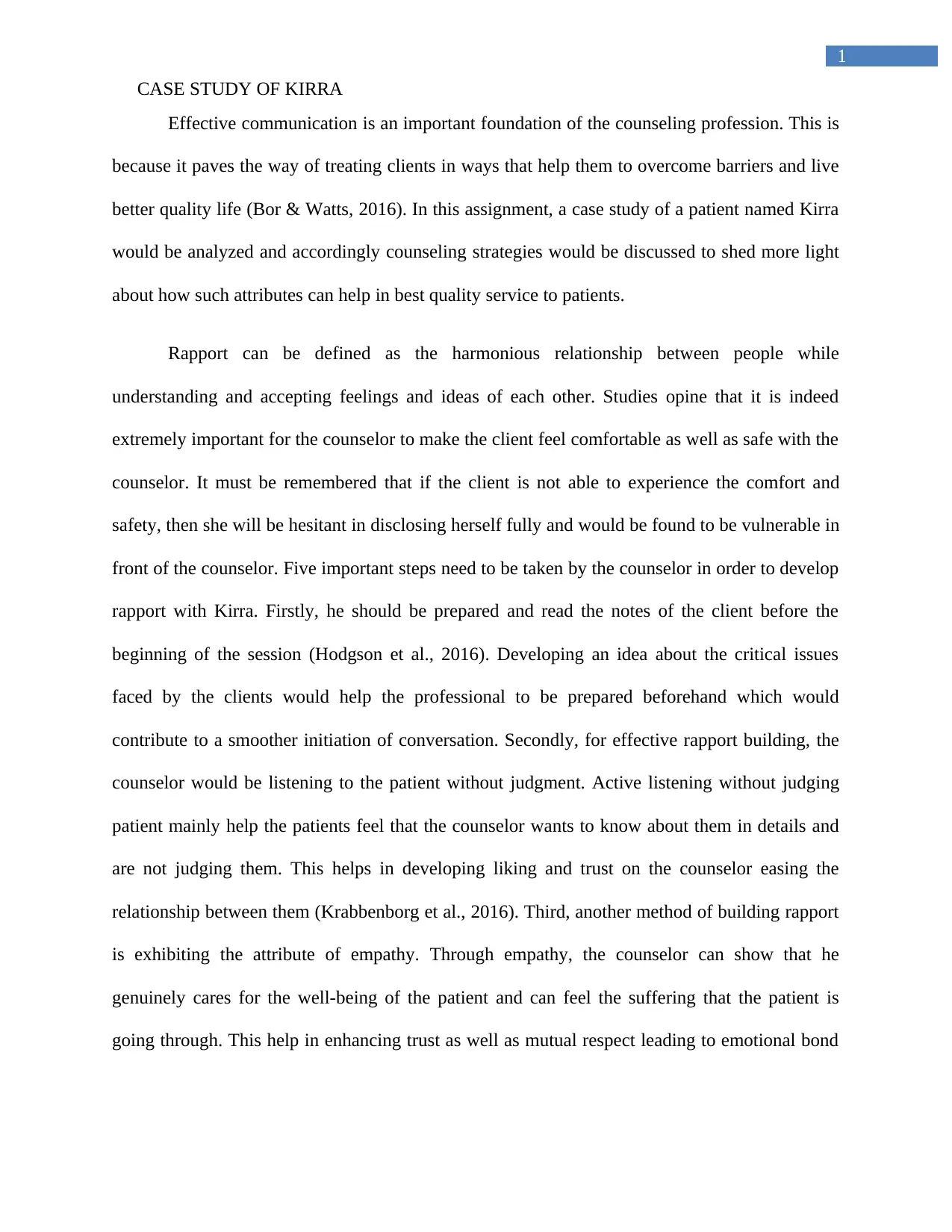
1
CASE STUDY OF KIRRA
Effective communication is an important foundation of the counseling profession. This is
because it paves the way of treating clients in ways that help them to overcome barriers and live
better quality life (Bor & Watts, 2016). In this assignment, a case study of a patient named Kirra
would be analyzed and accordingly counseling strategies would be discussed to shed more light
about how such attributes can help in best quality service to patients.
Rapport can be defined as the harmonious relationship between people while
understanding and accepting feelings and ideas of each other. Studies opine that it is indeed
extremely important for the counselor to make the client feel comfortable as well as safe with the
counselor. It must be remembered that if the client is not able to experience the comfort and
safety, then she will be hesitant in disclosing herself fully and would be found to be vulnerable in
front of the counselor. Five important steps need to be taken by the counselor in order to develop
rapport with Kirra. Firstly, he should be prepared and read the notes of the client before the
beginning of the session (Hodgson et al., 2016). Developing an idea about the critical issues
faced by the clients would help the professional to be prepared beforehand which would
contribute to a smoother initiation of conversation. Secondly, for effective rapport building, the
counselor would be listening to the patient without judgment. Active listening without judging
patient mainly help the patients feel that the counselor wants to know about them in details and
are not judging them. This helps in developing liking and trust on the counselor easing the
relationship between them (Krabbenborg et al., 2016). Third, another method of building rapport
is exhibiting the attribute of empathy. Through empathy, the counselor can show that he
genuinely cares for the well-being of the patient and can feel the suffering that the patient is
going through. This help in enhancing trust as well as mutual respect leading to emotional bond
CASE STUDY OF KIRRA
Effective communication is an important foundation of the counseling profession. This is
because it paves the way of treating clients in ways that help them to overcome barriers and live
better quality life (Bor & Watts, 2016). In this assignment, a case study of a patient named Kirra
would be analyzed and accordingly counseling strategies would be discussed to shed more light
about how such attributes can help in best quality service to patients.
Rapport can be defined as the harmonious relationship between people while
understanding and accepting feelings and ideas of each other. Studies opine that it is indeed
extremely important for the counselor to make the client feel comfortable as well as safe with the
counselor. It must be remembered that if the client is not able to experience the comfort and
safety, then she will be hesitant in disclosing herself fully and would be found to be vulnerable in
front of the counselor. Five important steps need to be taken by the counselor in order to develop
rapport with Kirra. Firstly, he should be prepared and read the notes of the client before the
beginning of the session (Hodgson et al., 2016). Developing an idea about the critical issues
faced by the clients would help the professional to be prepared beforehand which would
contribute to a smoother initiation of conversation. Secondly, for effective rapport building, the
counselor would be listening to the patient without judgment. Active listening without judging
patient mainly help the patients feel that the counselor wants to know about them in details and
are not judging them. This helps in developing liking and trust on the counselor easing the
relationship between them (Krabbenborg et al., 2016). Third, another method of building rapport
is exhibiting the attribute of empathy. Through empathy, the counselor can show that he
genuinely cares for the well-being of the patient and can feel the suffering that the patient is
going through. This help in enhancing trust as well as mutual respect leading to emotional bond
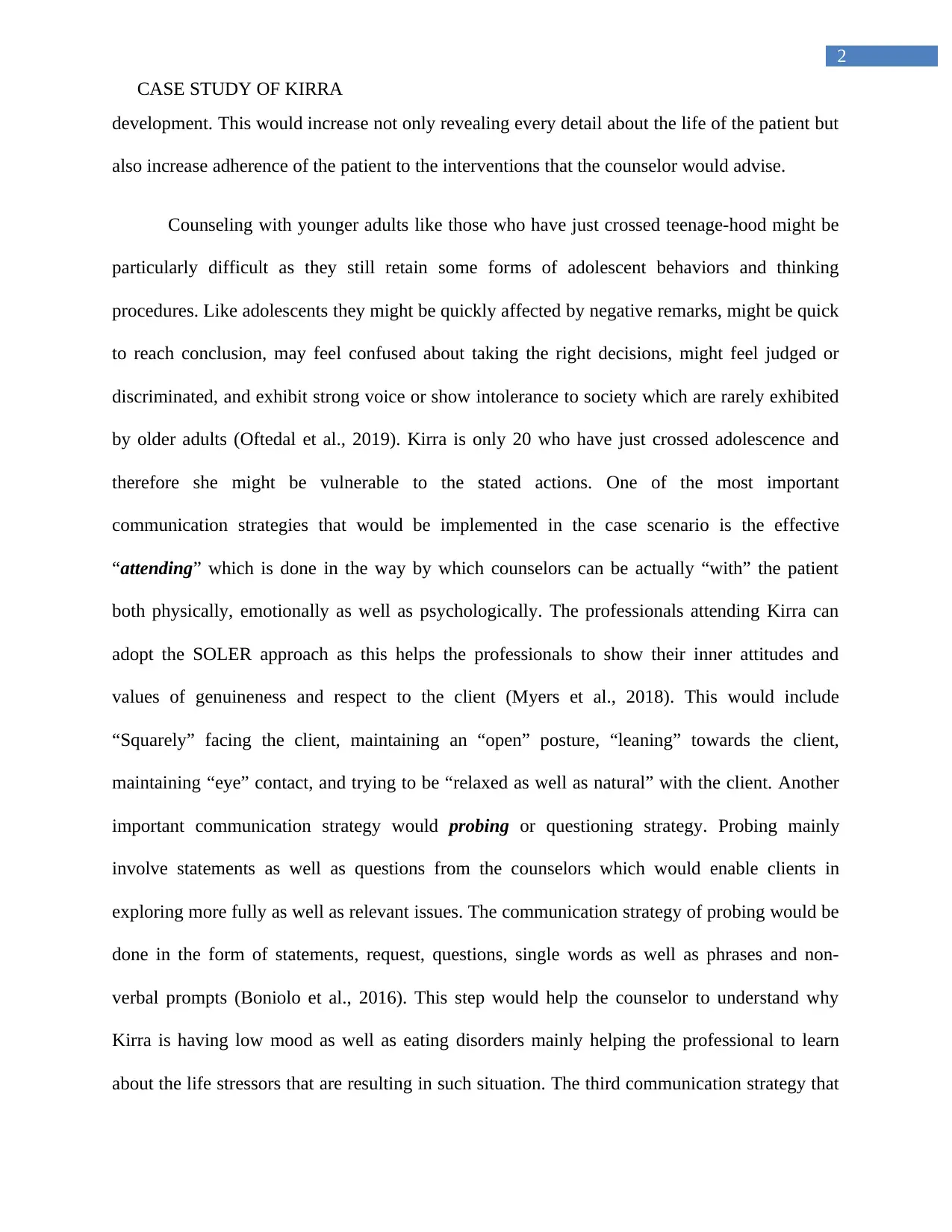
2
CASE STUDY OF KIRRA
development. This would increase not only revealing every detail about the life of the patient but
also increase adherence of the patient to the interventions that the counselor would advise.
Counseling with younger adults like those who have just crossed teenage-hood might be
particularly difficult as they still retain some forms of adolescent behaviors and thinking
procedures. Like adolescents they might be quickly affected by negative remarks, might be quick
to reach conclusion, may feel confused about taking the right decisions, might feel judged or
discriminated, and exhibit strong voice or show intolerance to society which are rarely exhibited
by older adults (Oftedal et al., 2019). Kirra is only 20 who have just crossed adolescence and
therefore she might be vulnerable to the stated actions. One of the most important
communication strategies that would be implemented in the case scenario is the effective
“attending” which is done in the way by which counselors can be actually “with” the patient
both physically, emotionally as well as psychologically. The professionals attending Kirra can
adopt the SOLER approach as this helps the professionals to show their inner attitudes and
values of genuineness and respect to the client (Myers et al., 2018). This would include
“Squarely” facing the client, maintaining an “open” posture, “leaning” towards the client,
maintaining “eye” contact, and trying to be “relaxed as well as natural” with the client. Another
important communication strategy would probing or questioning strategy. Probing mainly
involve statements as well as questions from the counselors which would enable clients in
exploring more fully as well as relevant issues. The communication strategy of probing would be
done in the form of statements, request, questions, single words as well as phrases and non-
verbal prompts (Boniolo et al., 2016). This step would help the counselor to understand why
Kirra is having low mood as well as eating disorders mainly helping the professional to learn
about the life stressors that are resulting in such situation. The third communication strategy that
CASE STUDY OF KIRRA
development. This would increase not only revealing every detail about the life of the patient but
also increase adherence of the patient to the interventions that the counselor would advise.
Counseling with younger adults like those who have just crossed teenage-hood might be
particularly difficult as they still retain some forms of adolescent behaviors and thinking
procedures. Like adolescents they might be quickly affected by negative remarks, might be quick
to reach conclusion, may feel confused about taking the right decisions, might feel judged or
discriminated, and exhibit strong voice or show intolerance to society which are rarely exhibited
by older adults (Oftedal et al., 2019). Kirra is only 20 who have just crossed adolescence and
therefore she might be vulnerable to the stated actions. One of the most important
communication strategies that would be implemented in the case scenario is the effective
“attending” which is done in the way by which counselors can be actually “with” the patient
both physically, emotionally as well as psychologically. The professionals attending Kirra can
adopt the SOLER approach as this helps the professionals to show their inner attitudes and
values of genuineness and respect to the client (Myers et al., 2018). This would include
“Squarely” facing the client, maintaining an “open” posture, “leaning” towards the client,
maintaining “eye” contact, and trying to be “relaxed as well as natural” with the client. Another
important communication strategy would probing or questioning strategy. Probing mainly
involve statements as well as questions from the counselors which would enable clients in
exploring more fully as well as relevant issues. The communication strategy of probing would be
done in the form of statements, request, questions, single words as well as phrases and non-
verbal prompts (Boniolo et al., 2016). This step would help the counselor to understand why
Kirra is having low mood as well as eating disorders mainly helping the professional to learn
about the life stressors that are resulting in such situation. The third communication strategy that
⊘ This is a preview!⊘
Do you want full access?
Subscribe today to unlock all pages.

Trusted by 1+ million students worldwide
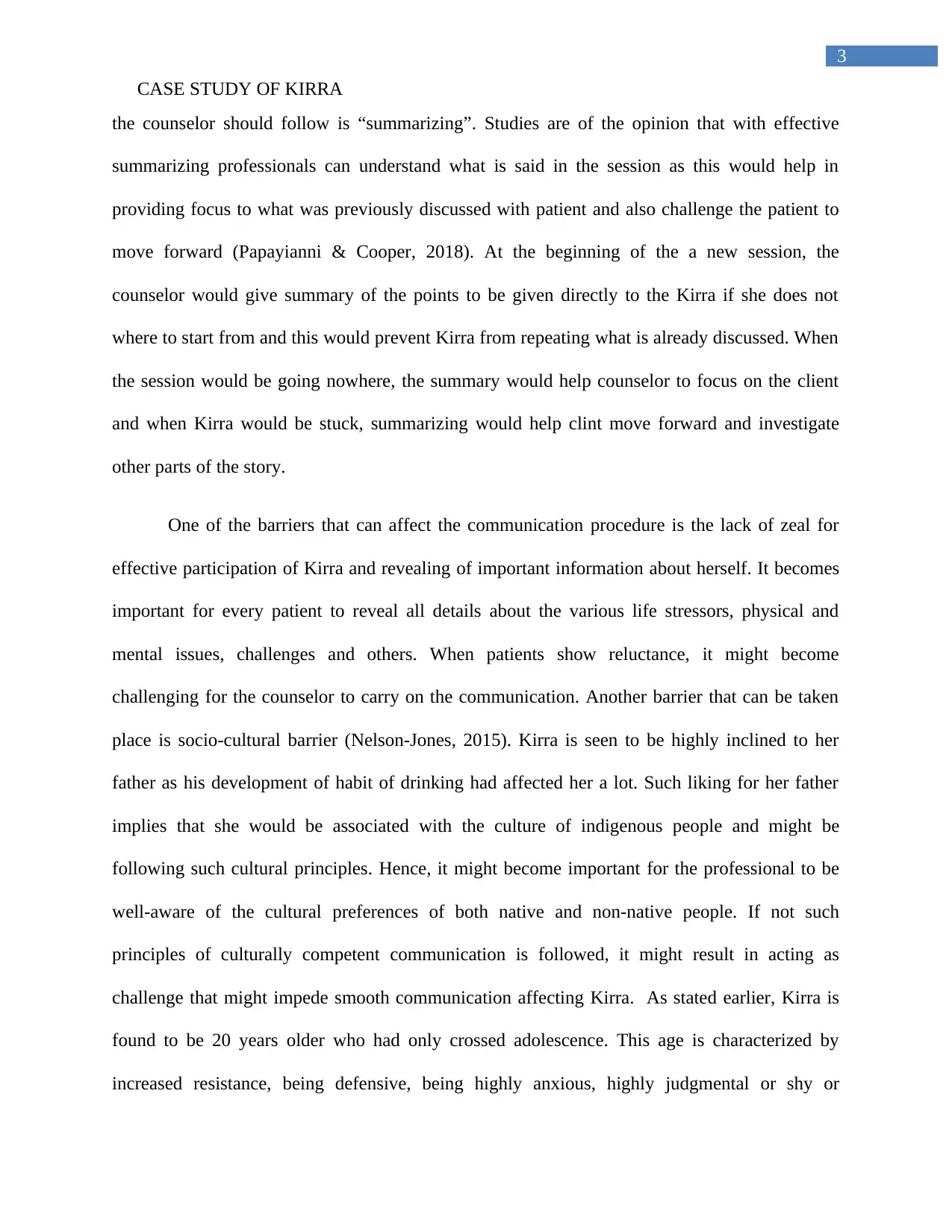
3
CASE STUDY OF KIRRA
the counselor should follow is “summarizing”. Studies are of the opinion that with effective
summarizing professionals can understand what is said in the session as this would help in
providing focus to what was previously discussed with patient and also challenge the patient to
move forward (Papayianni & Cooper, 2018). At the beginning of the a new session, the
counselor would give summary of the points to be given directly to the Kirra if she does not
where to start from and this would prevent Kirra from repeating what is already discussed. When
the session would be going nowhere, the summary would help counselor to focus on the client
and when Kirra would be stuck, summarizing would help clint move forward and investigate
other parts of the story.
One of the barriers that can affect the communication procedure is the lack of zeal for
effective participation of Kirra and revealing of important information about herself. It becomes
important for every patient to reveal all details about the various life stressors, physical and
mental issues, challenges and others. When patients show reluctance, it might become
challenging for the counselor to carry on the communication. Another barrier that can be taken
place is socio-cultural barrier (Nelson-Jones, 2015). Kirra is seen to be highly inclined to her
father as his development of habit of drinking had affected her a lot. Such liking for her father
implies that she would be associated with the culture of indigenous people and might be
following such cultural principles. Hence, it might become important for the professional to be
well-aware of the cultural preferences of both native and non-native people. If not such
principles of culturally competent communication is followed, it might result in acting as
challenge that might impede smooth communication affecting Kirra. As stated earlier, Kirra is
found to be 20 years older who had only crossed adolescence. This age is characterized by
increased resistance, being defensive, being highly anxious, highly judgmental or shy or
CASE STUDY OF KIRRA
the counselor should follow is “summarizing”. Studies are of the opinion that with effective
summarizing professionals can understand what is said in the session as this would help in
providing focus to what was previously discussed with patient and also challenge the patient to
move forward (Papayianni & Cooper, 2018). At the beginning of the a new session, the
counselor would give summary of the points to be given directly to the Kirra if she does not
where to start from and this would prevent Kirra from repeating what is already discussed. When
the session would be going nowhere, the summary would help counselor to focus on the client
and when Kirra would be stuck, summarizing would help clint move forward and investigate
other parts of the story.
One of the barriers that can affect the communication procedure is the lack of zeal for
effective participation of Kirra and revealing of important information about herself. It becomes
important for every patient to reveal all details about the various life stressors, physical and
mental issues, challenges and others. When patients show reluctance, it might become
challenging for the counselor to carry on the communication. Another barrier that can be taken
place is socio-cultural barrier (Nelson-Jones, 2015). Kirra is seen to be highly inclined to her
father as his development of habit of drinking had affected her a lot. Such liking for her father
implies that she would be associated with the culture of indigenous people and might be
following such cultural principles. Hence, it might become important for the professional to be
well-aware of the cultural preferences of both native and non-native people. If not such
principles of culturally competent communication is followed, it might result in acting as
challenge that might impede smooth communication affecting Kirra. As stated earlier, Kirra is
found to be 20 years older who had only crossed adolescence. This age is characterized by
increased resistance, being defensive, being highly anxious, highly judgmental or shy or
Paraphrase This Document
Need a fresh take? Get an instant paraphrase of this document with our AI Paraphraser
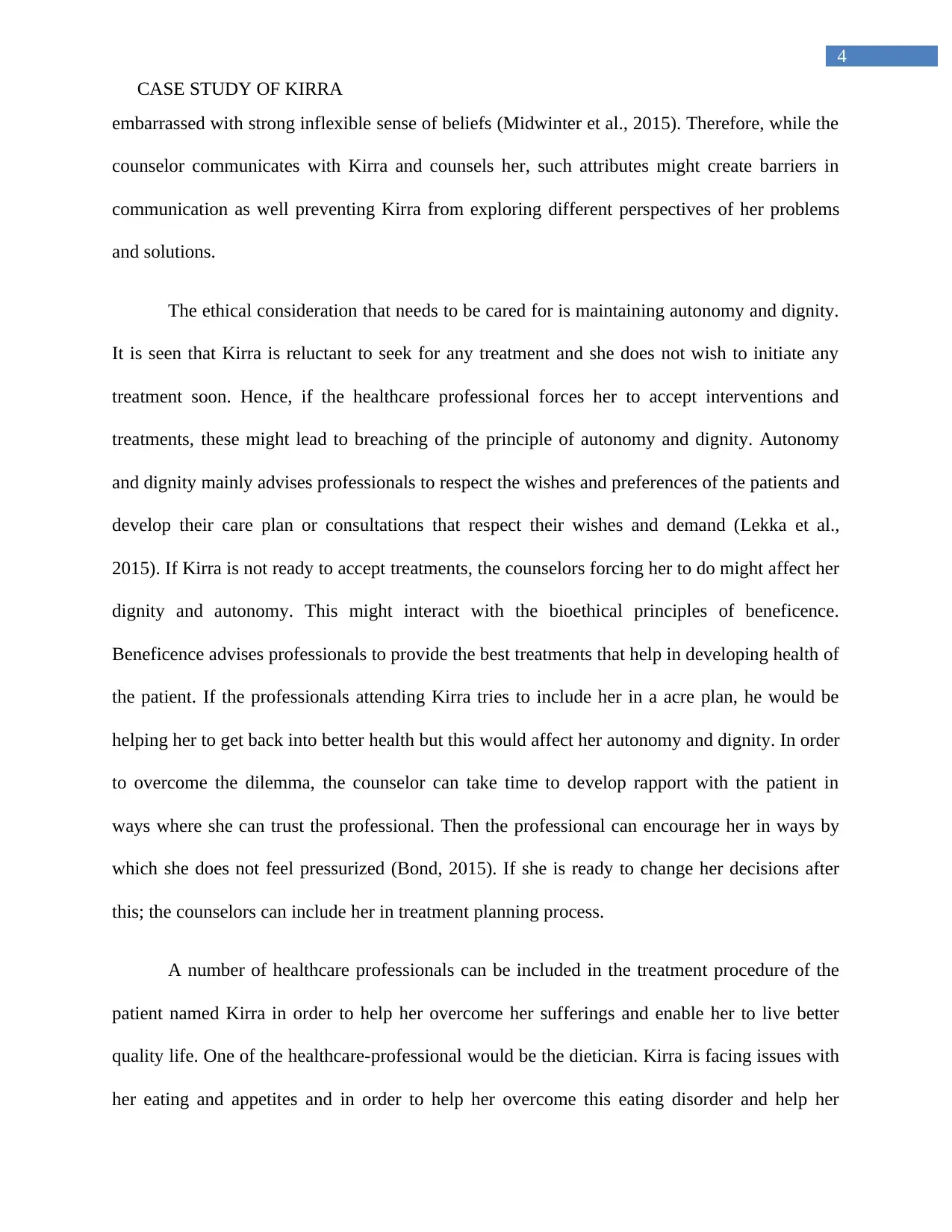
4
CASE STUDY OF KIRRA
embarrassed with strong inflexible sense of beliefs (Midwinter et al., 2015). Therefore, while the
counselor communicates with Kirra and counsels her, such attributes might create barriers in
communication as well preventing Kirra from exploring different perspectives of her problems
and solutions.
The ethical consideration that needs to be cared for is maintaining autonomy and dignity.
It is seen that Kirra is reluctant to seek for any treatment and she does not wish to initiate any
treatment soon. Hence, if the healthcare professional forces her to accept interventions and
treatments, these might lead to breaching of the principle of autonomy and dignity. Autonomy
and dignity mainly advises professionals to respect the wishes and preferences of the patients and
develop their care plan or consultations that respect their wishes and demand (Lekka et al.,
2015). If Kirra is not ready to accept treatments, the counselors forcing her to do might affect her
dignity and autonomy. This might interact with the bioethical principles of beneficence.
Beneficence advises professionals to provide the best treatments that help in developing health of
the patient. If the professionals attending Kirra tries to include her in a acre plan, he would be
helping her to get back into better health but this would affect her autonomy and dignity. In order
to overcome the dilemma, the counselor can take time to develop rapport with the patient in
ways where she can trust the professional. Then the professional can encourage her in ways by
which she does not feel pressurized (Bond, 2015). If she is ready to change her decisions after
this; the counselors can include her in treatment planning process.
A number of healthcare professionals can be included in the treatment procedure of the
patient named Kirra in order to help her overcome her sufferings and enable her to live better
quality life. One of the healthcare-professional would be the dietician. Kirra is facing issues with
her eating and appetites and in order to help her overcome this eating disorder and help her
CASE STUDY OF KIRRA
embarrassed with strong inflexible sense of beliefs (Midwinter et al., 2015). Therefore, while the
counselor communicates with Kirra and counsels her, such attributes might create barriers in
communication as well preventing Kirra from exploring different perspectives of her problems
and solutions.
The ethical consideration that needs to be cared for is maintaining autonomy and dignity.
It is seen that Kirra is reluctant to seek for any treatment and she does not wish to initiate any
treatment soon. Hence, if the healthcare professional forces her to accept interventions and
treatments, these might lead to breaching of the principle of autonomy and dignity. Autonomy
and dignity mainly advises professionals to respect the wishes and preferences of the patients and
develop their care plan or consultations that respect their wishes and demand (Lekka et al.,
2015). If Kirra is not ready to accept treatments, the counselors forcing her to do might affect her
dignity and autonomy. This might interact with the bioethical principles of beneficence.
Beneficence advises professionals to provide the best treatments that help in developing health of
the patient. If the professionals attending Kirra tries to include her in a acre plan, he would be
helping her to get back into better health but this would affect her autonomy and dignity. In order
to overcome the dilemma, the counselor can take time to develop rapport with the patient in
ways where she can trust the professional. Then the professional can encourage her in ways by
which she does not feel pressurized (Bond, 2015). If she is ready to change her decisions after
this; the counselors can include her in treatment planning process.
A number of healthcare professionals can be included in the treatment procedure of the
patient named Kirra in order to help her overcome her sufferings and enable her to live better
quality life. One of the healthcare-professional would be the dietician. Kirra is facing issues with
her eating and appetites and in order to help her overcome this eating disorder and help her
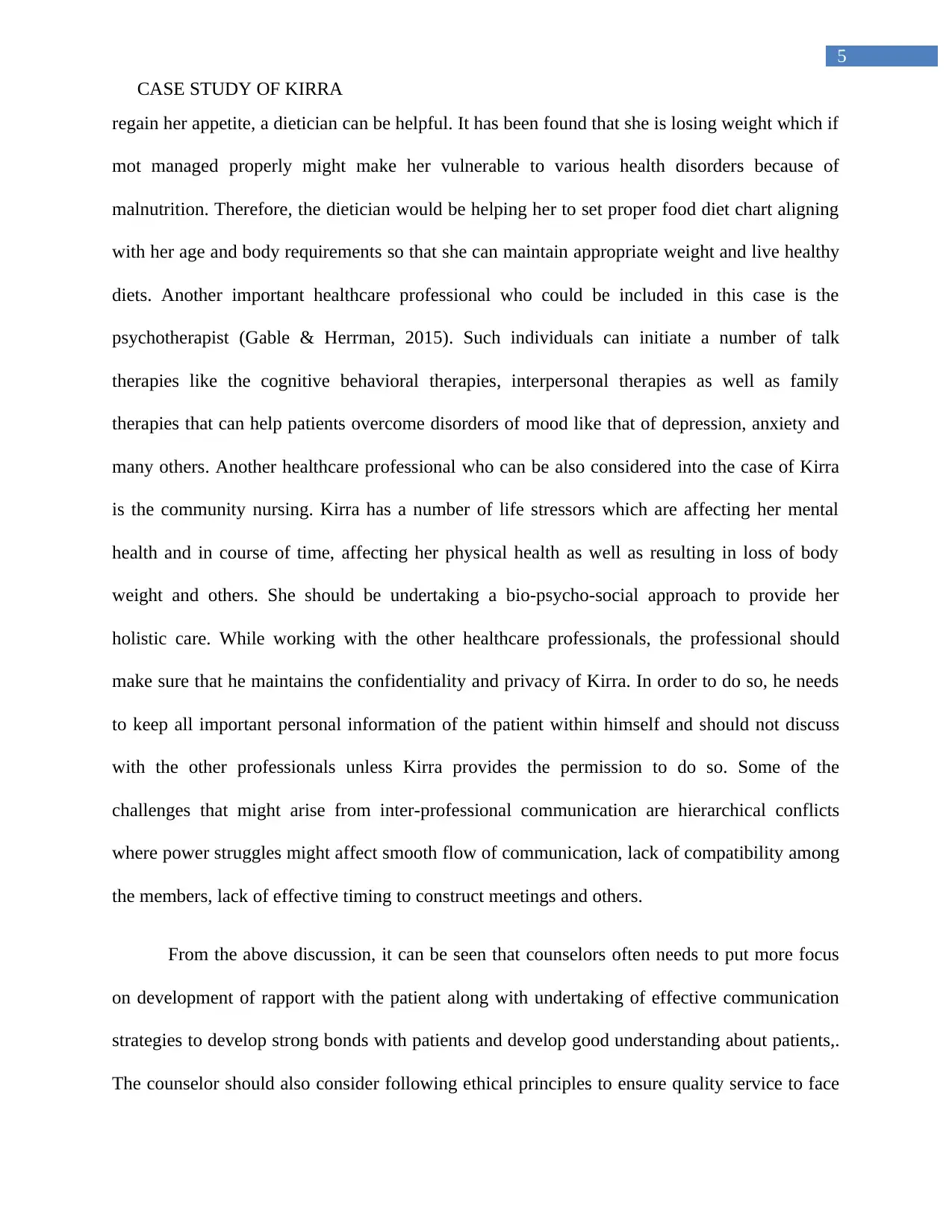
5
CASE STUDY OF KIRRA
regain her appetite, a dietician can be helpful. It has been found that she is losing weight which if
mot managed properly might make her vulnerable to various health disorders because of
malnutrition. Therefore, the dietician would be helping her to set proper food diet chart aligning
with her age and body requirements so that she can maintain appropriate weight and live healthy
diets. Another important healthcare professional who could be included in this case is the
psychotherapist (Gable & Herrman, 2015). Such individuals can initiate a number of talk
therapies like the cognitive behavioral therapies, interpersonal therapies as well as family
therapies that can help patients overcome disorders of mood like that of depression, anxiety and
many others. Another healthcare professional who can be also considered into the case of Kirra
is the community nursing. Kirra has a number of life stressors which are affecting her mental
health and in course of time, affecting her physical health as well as resulting in loss of body
weight and others. She should be undertaking a bio-psycho-social approach to provide her
holistic care. While working with the other healthcare professionals, the professional should
make sure that he maintains the confidentiality and privacy of Kirra. In order to do so, he needs
to keep all important personal information of the patient within himself and should not discuss
with the other professionals unless Kirra provides the permission to do so. Some of the
challenges that might arise from inter-professional communication are hierarchical conflicts
where power struggles might affect smooth flow of communication, lack of compatibility among
the members, lack of effective timing to construct meetings and others.
From the above discussion, it can be seen that counselors often needs to put more focus
on development of rapport with the patient along with undertaking of effective communication
strategies to develop strong bonds with patients and develop good understanding about patients,.
The counselor should also consider following ethical principles to ensure quality service to face
CASE STUDY OF KIRRA
regain her appetite, a dietician can be helpful. It has been found that she is losing weight which if
mot managed properly might make her vulnerable to various health disorders because of
malnutrition. Therefore, the dietician would be helping her to set proper food diet chart aligning
with her age and body requirements so that she can maintain appropriate weight and live healthy
diets. Another important healthcare professional who could be included in this case is the
psychotherapist (Gable & Herrman, 2015). Such individuals can initiate a number of talk
therapies like the cognitive behavioral therapies, interpersonal therapies as well as family
therapies that can help patients overcome disorders of mood like that of depression, anxiety and
many others. Another healthcare professional who can be also considered into the case of Kirra
is the community nursing. Kirra has a number of life stressors which are affecting her mental
health and in course of time, affecting her physical health as well as resulting in loss of body
weight and others. She should be undertaking a bio-psycho-social approach to provide her
holistic care. While working with the other healthcare professionals, the professional should
make sure that he maintains the confidentiality and privacy of Kirra. In order to do so, he needs
to keep all important personal information of the patient within himself and should not discuss
with the other professionals unless Kirra provides the permission to do so. Some of the
challenges that might arise from inter-professional communication are hierarchical conflicts
where power struggles might affect smooth flow of communication, lack of compatibility among
the members, lack of effective timing to construct meetings and others.
From the above discussion, it can be seen that counselors often needs to put more focus
on development of rapport with the patient along with undertaking of effective communication
strategies to develop strong bonds with patients and develop good understanding about patients,.
The counselor should also consider following ethical principles to ensure quality service to face
⊘ This is a preview!⊘
Do you want full access?
Subscribe today to unlock all pages.

Trusted by 1+ million students worldwide
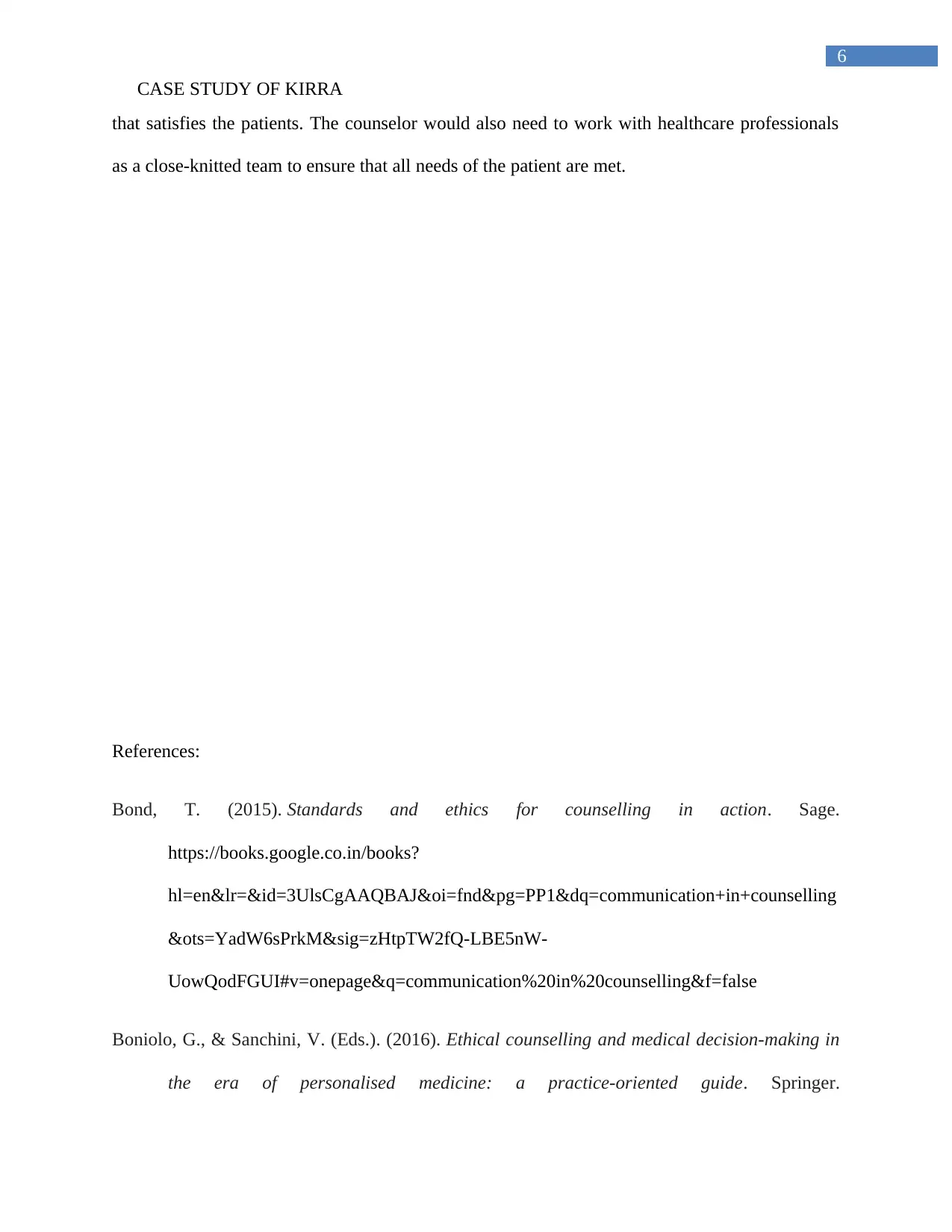
6
CASE STUDY OF KIRRA
that satisfies the patients. The counselor would also need to work with healthcare professionals
as a close-knitted team to ensure that all needs of the patient are met.
References:
Bond, T. (2015). Standards and ethics for counselling in action. Sage.
https://books.google.co.in/books?
hl=en&lr=&id=3UlsCgAAQBAJ&oi=fnd&pg=PP1&dq=communication+in+counselling
&ots=YadW6sPrkM&sig=zHtpTW2fQ-LBE5nW-
UowQodFGUI#v=onepage&q=communication%20in%20counselling&f=false
Boniolo, G., & Sanchini, V. (Eds.). (2016). Ethical counselling and medical decision-making in
the era of personalised medicine: a practice-oriented guide. Springer.
CASE STUDY OF KIRRA
that satisfies the patients. The counselor would also need to work with healthcare professionals
as a close-knitted team to ensure that all needs of the patient are met.
References:
Bond, T. (2015). Standards and ethics for counselling in action. Sage.
https://books.google.co.in/books?
hl=en&lr=&id=3UlsCgAAQBAJ&oi=fnd&pg=PP1&dq=communication+in+counselling
&ots=YadW6sPrkM&sig=zHtpTW2fQ-LBE5nW-
UowQodFGUI#v=onepage&q=communication%20in%20counselling&f=false
Boniolo, G., & Sanchini, V. (Eds.). (2016). Ethical counselling and medical decision-making in
the era of personalised medicine: a practice-oriented guide. Springer.
Paraphrase This Document
Need a fresh take? Get an instant paraphrase of this document with our AI Paraphraser
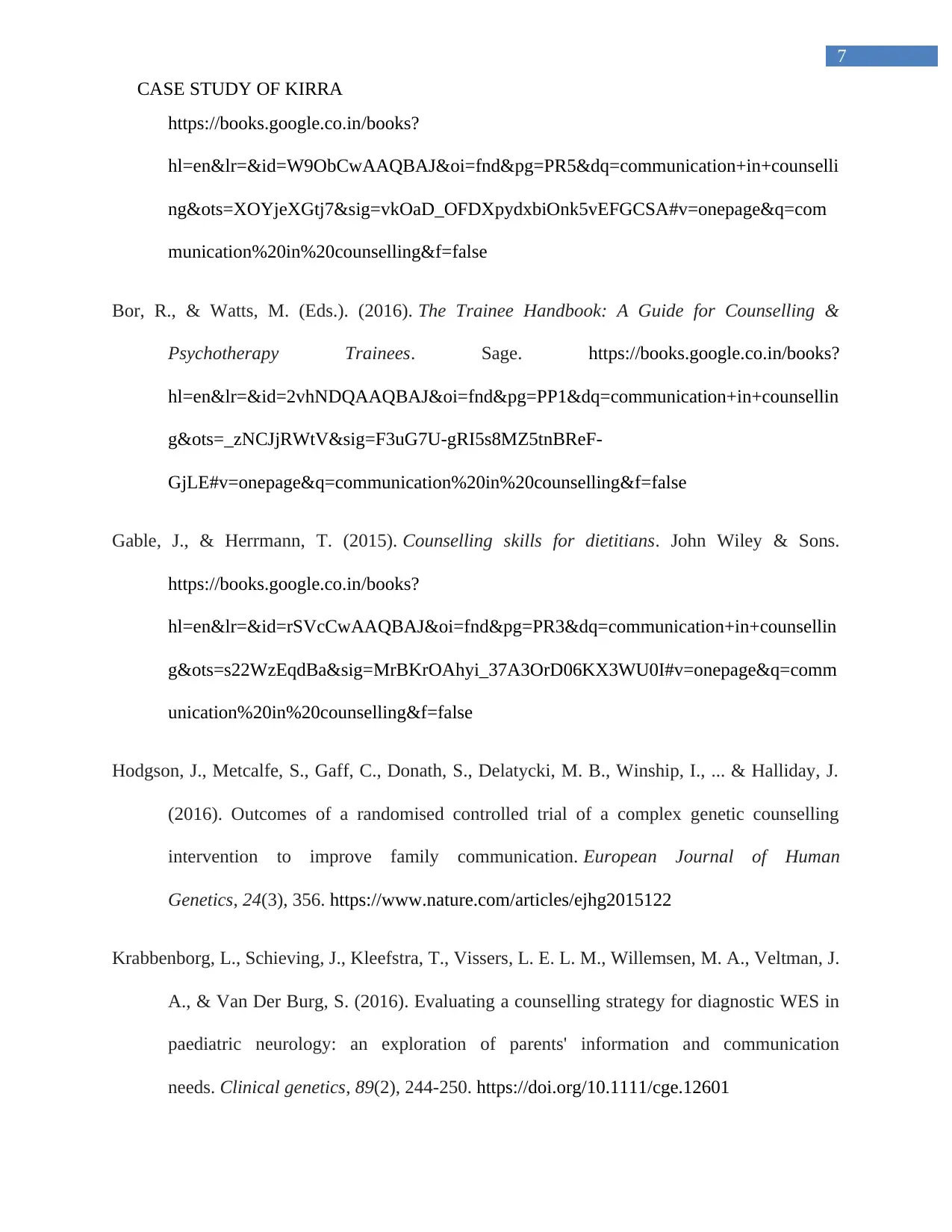
7
CASE STUDY OF KIRRA
https://books.google.co.in/books?
hl=en&lr=&id=W9ObCwAAQBAJ&oi=fnd&pg=PR5&dq=communication+in+counselli
ng&ots=XOYjeXGtj7&sig=vkOaD_OFDXpydxbiOnk5vEFGCSA#v=onepage&q=com
munication%20in%20counselling&f=false
Bor, R., & Watts, M. (Eds.). (2016). The Trainee Handbook: A Guide for Counselling &
Psychotherapy Trainees. Sage. https://books.google.co.in/books?
hl=en&lr=&id=2vhNDQAAQBAJ&oi=fnd&pg=PP1&dq=communication+in+counsellin
g&ots=_zNCJjRWtV&sig=F3uG7U-gRI5s8MZ5tnBReF-
GjLE#v=onepage&q=communication%20in%20counselling&f=false
Gable, J., & Herrmann, T. (2015). Counselling skills for dietitians. John Wiley & Sons.
https://books.google.co.in/books?
hl=en&lr=&id=rSVcCwAAQBAJ&oi=fnd&pg=PR3&dq=communication+in+counsellin
g&ots=s22WzEqdBa&sig=MrBKrOAhyi_37A3OrD06KX3WU0I#v=onepage&q=comm
unication%20in%20counselling&f=false
Hodgson, J., Metcalfe, S., Gaff, C., Donath, S., Delatycki, M. B., Winship, I., ... & Halliday, J.
(2016). Outcomes of a randomised controlled trial of a complex genetic counselling
intervention to improve family communication. European Journal of Human
Genetics, 24(3), 356. https://www.nature.com/articles/ejhg2015122
Krabbenborg, L., Schieving, J., Kleefstra, T., Vissers, L. E. L. M., Willemsen, M. A., Veltman, J.
A., & Van Der Burg, S. (2016). Evaluating a counselling strategy for diagnostic WES in
paediatric neurology: an exploration of parents' information and communication
needs. Clinical genetics, 89(2), 244-250. https://doi.org/10.1111/cge.12601
CASE STUDY OF KIRRA
https://books.google.co.in/books?
hl=en&lr=&id=W9ObCwAAQBAJ&oi=fnd&pg=PR5&dq=communication+in+counselli
ng&ots=XOYjeXGtj7&sig=vkOaD_OFDXpydxbiOnk5vEFGCSA#v=onepage&q=com
munication%20in%20counselling&f=false
Bor, R., & Watts, M. (Eds.). (2016). The Trainee Handbook: A Guide for Counselling &
Psychotherapy Trainees. Sage. https://books.google.co.in/books?
hl=en&lr=&id=2vhNDQAAQBAJ&oi=fnd&pg=PP1&dq=communication+in+counsellin
g&ots=_zNCJjRWtV&sig=F3uG7U-gRI5s8MZ5tnBReF-
GjLE#v=onepage&q=communication%20in%20counselling&f=false
Gable, J., & Herrmann, T. (2015). Counselling skills for dietitians. John Wiley & Sons.
https://books.google.co.in/books?
hl=en&lr=&id=rSVcCwAAQBAJ&oi=fnd&pg=PR3&dq=communication+in+counsellin
g&ots=s22WzEqdBa&sig=MrBKrOAhyi_37A3OrD06KX3WU0I#v=onepage&q=comm
unication%20in%20counselling&f=false
Hodgson, J., Metcalfe, S., Gaff, C., Donath, S., Delatycki, M. B., Winship, I., ... & Halliday, J.
(2016). Outcomes of a randomised controlled trial of a complex genetic counselling
intervention to improve family communication. European Journal of Human
Genetics, 24(3), 356. https://www.nature.com/articles/ejhg2015122
Krabbenborg, L., Schieving, J., Kleefstra, T., Vissers, L. E. L. M., Willemsen, M. A., Veltman, J.
A., & Van Der Burg, S. (2016). Evaluating a counselling strategy for diagnostic WES in
paediatric neurology: an exploration of parents' information and communication
needs. Clinical genetics, 89(2), 244-250. https://doi.org/10.1111/cge.12601
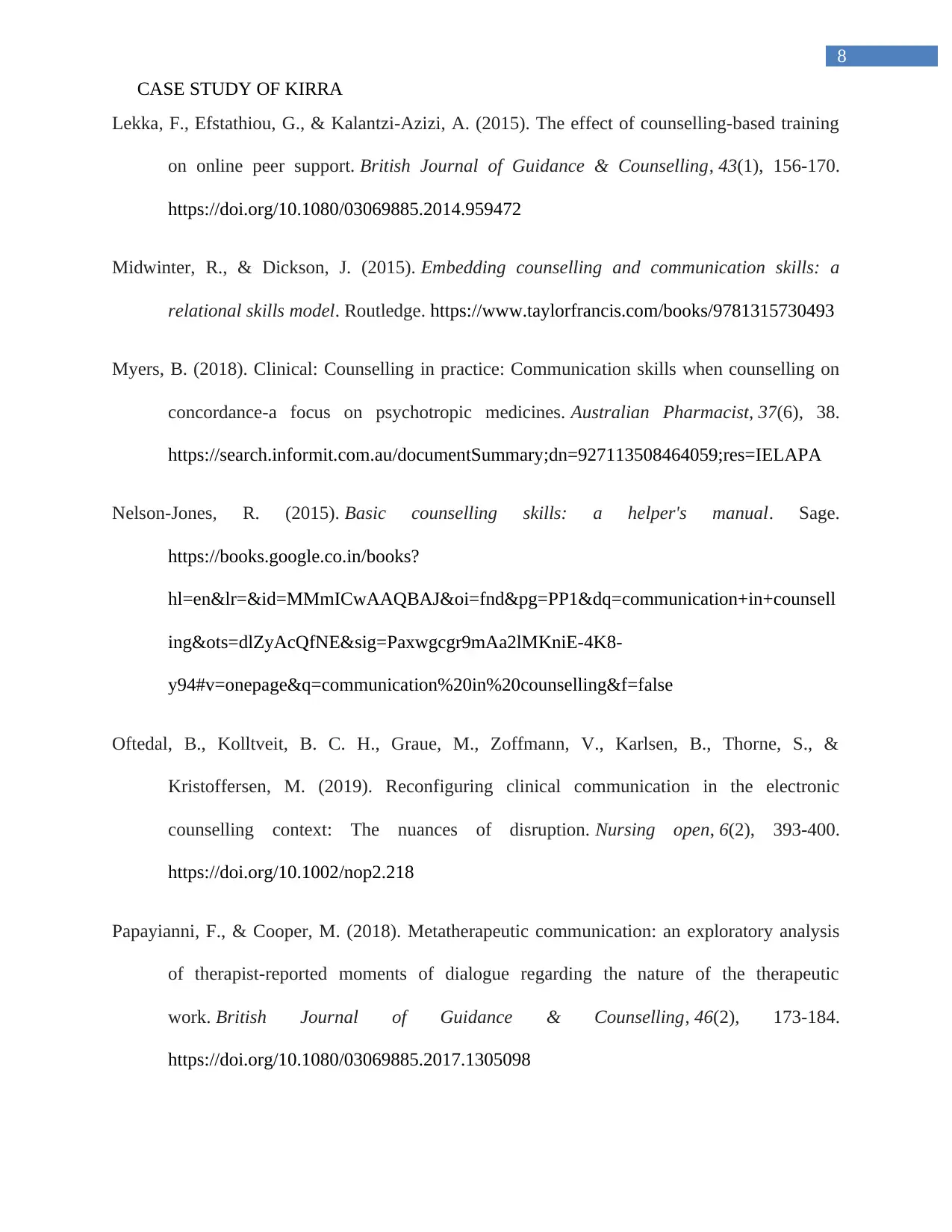
8
CASE STUDY OF KIRRA
Lekka, F., Efstathiou, G., & Kalantzi-Azizi, A. (2015). The effect of counselling-based training
on online peer support. British Journal of Guidance & Counselling, 43(1), 156-170.
https://doi.org/10.1080/03069885.2014.959472
Midwinter, R., & Dickson, J. (2015). Embedding counselling and communication skills: a
relational skills model. Routledge. https://www.taylorfrancis.com/books/9781315730493
Myers, B. (2018). Clinical: Counselling in practice: Communication skills when counselling on
concordance-a focus on psychotropic medicines. Australian Pharmacist, 37(6), 38.
https://search.informit.com.au/documentSummary;dn=927113508464059;res=IELAPA
Nelson-Jones, R. (2015). Basic counselling skills: a helper's manual. Sage.
https://books.google.co.in/books?
hl=en&lr=&id=MMmICwAAQBAJ&oi=fnd&pg=PP1&dq=communication+in+counsell
ing&ots=dlZyAcQfNE&sig=Paxwgcgr9mAa2lMKniE-4K8-
y94#v=onepage&q=communication%20in%20counselling&f=false
Oftedal, B., Kolltveit, B. C. H., Graue, M., Zoffmann, V., Karlsen, B., Thorne, S., &
Kristoffersen, M. (2019). Reconfiguring clinical communication in the electronic
counselling context: The nuances of disruption. Nursing open, 6(2), 393-400.
https://doi.org/10.1002/nop2.218
Papayianni, F., & Cooper, M. (2018). Metatherapeutic communication: an exploratory analysis
of therapist-reported moments of dialogue regarding the nature of the therapeutic
work. British Journal of Guidance & Counselling, 46(2), 173-184.
https://doi.org/10.1080/03069885.2017.1305098
CASE STUDY OF KIRRA
Lekka, F., Efstathiou, G., & Kalantzi-Azizi, A. (2015). The effect of counselling-based training
on online peer support. British Journal of Guidance & Counselling, 43(1), 156-170.
https://doi.org/10.1080/03069885.2014.959472
Midwinter, R., & Dickson, J. (2015). Embedding counselling and communication skills: a
relational skills model. Routledge. https://www.taylorfrancis.com/books/9781315730493
Myers, B. (2018). Clinical: Counselling in practice: Communication skills when counselling on
concordance-a focus on psychotropic medicines. Australian Pharmacist, 37(6), 38.
https://search.informit.com.au/documentSummary;dn=927113508464059;res=IELAPA
Nelson-Jones, R. (2015). Basic counselling skills: a helper's manual. Sage.
https://books.google.co.in/books?
hl=en&lr=&id=MMmICwAAQBAJ&oi=fnd&pg=PP1&dq=communication+in+counsell
ing&ots=dlZyAcQfNE&sig=Paxwgcgr9mAa2lMKniE-4K8-
y94#v=onepage&q=communication%20in%20counselling&f=false
Oftedal, B., Kolltveit, B. C. H., Graue, M., Zoffmann, V., Karlsen, B., Thorne, S., &
Kristoffersen, M. (2019). Reconfiguring clinical communication in the electronic
counselling context: The nuances of disruption. Nursing open, 6(2), 393-400.
https://doi.org/10.1002/nop2.218
Papayianni, F., & Cooper, M. (2018). Metatherapeutic communication: an exploratory analysis
of therapist-reported moments of dialogue regarding the nature of the therapeutic
work. British Journal of Guidance & Counselling, 46(2), 173-184.
https://doi.org/10.1080/03069885.2017.1305098
⊘ This is a preview!⊘
Do you want full access?
Subscribe today to unlock all pages.

Trusted by 1+ million students worldwide

9
CASE STUDY OF KIRRA
CASE STUDY OF KIRRA
Paraphrase This Document
Need a fresh take? Get an instant paraphrase of this document with our AI Paraphraser

10
CASE STUDY OF KIRRA
CASE STUDY OF KIRRA
1 out of 11
Related Documents
Your All-in-One AI-Powered Toolkit for Academic Success.
+13062052269
info@desklib.com
Available 24*7 on WhatsApp / Email
![[object Object]](/_next/static/media/star-bottom.7253800d.svg)
Unlock your academic potential
Copyright © 2020–2025 A2Z Services. All Rights Reserved. Developed and managed by ZUCOL.




